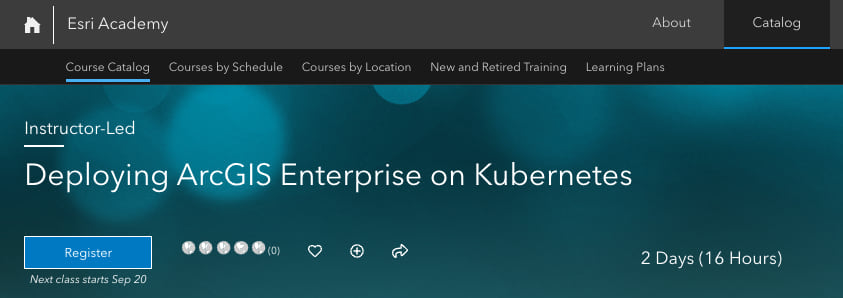Kubernetes is a popular topic at Esri, and lots of folks have questions about what that means for their ArcGIS Enterprise deployment or for their organization. Have you ever wondered if you should consider moving to ArcGIS Enterprise on Kubernetes?
Each year, we create the Esri User Conference (Esri UC) Q&A from our users’ feedback and queries. Even though this information is put out before the July User Conference, the information is useful for anyone who wants information about ArcGIS Enterprise year-round. Esri leadership and subject matter experts work together to answer a series of questions asked by our community, and these experts share their vision for the GIS industry and provide an update on the latest advancements in Esri technology.
This year, we had lots of questions about Kubernetes, and wanted to give you information to help guide your time in San Diego and beyond. Let’s dive in!
1. What is ArcGIS Enterprise on Kubernetes?
ArcGIS Enterprise on Kubernetes is a cloud-native deployment option for ArcGIS Enterprise based on a microservices architecture and delivered through containerization. It can run on your cloud or on-premises environment.
Kubernetes simplifies deployment and upgrades, provides resiliency, and scales resources dynamically. It keeps your GIS services responsive and highly available, while reducing administrative effort. This is a major strategic investment by Esri, and we believe it can help our customers address the rapidly increasing use of GIS in the world today.
2. How will ArcGIS Enterprise on Kubernetes benefit me?
For our customers who have a modern cloud strategy, ArcGIS Enterprise on Kubernetes provides several benefits. Administrators can enjoy fast, simplified deployment and upgrade experiences, which no longer require preparing and managing individual servers and virtual machines. You also receive increased visibility into the system’s health, thanks to granular logging and metrics for individual system- and user-managed services.
Architects and IT teams appreciate that the system provides high availability out-of-the-box, without the need for multiple redundant servers, thanks to the built-in monitoring and recovery abilities of Kubernetes. You can fine-tune system performance for resources you have availability today, and set up rules in advance for the software to auto-scale in response to spikes in demand.
End users will have a similar ArcGIS Enterprise experience no matter what technology is being used behind the scenes (Windows, Linux, or Kubernetes). However, you may notice indirect improvements such as consistent performance and system responsiveness that does not fluctuate even in times of high demand. This stability is another benefit of the resource management provided by Kubernetes orchestration.
IT managers may enjoy reduced infrastructure administrative costs. You can design resources for today’s needs and scale in the future as needed, without needing standby compute or memory. See 3 Things You Need to Know about ArcGIS Enterprise on Kubernetes for more information.
3. How can my team prepare for ArcGIS Enterprise on Kubernetes?
Updated 9/19/23: Esri’s new training course is here! This intensive course includes hands-on exercises, where you’ll create a new ArcGIS Enterprise on Kubernetes deployment and practice working with it. By the end, you’ll understand how to prepare for Kubernetes, considerations for moving to cloud native, and more. Visit the Esri Academy page to register for this 2-day instructor-led course. The next course begins on October 24, 2023.







great features!
Any solution/tool/widget in the future to manage dynamic contents as news, articles etc as we do with external CMS?
Hi, we do not have this on our immediate roadmap, but we’ve taken note of your comment for future planning! Today, you can consider using an iframe card to embed a custom widget or use the social media card for sharing news. For more information, see this help topic: https://enterprise.arcgis.com/en/portal/latest/use/embed-video-social-media-and-iframes.htm
anyway to link to another site directly in a site? In 10.7 this seemed simple using a category option but in 10.8 seems to want to direct users first to the linked sites details page then you have to use the open button? Or have I missed something here?
Hi, are there any plans to bring the smart search functionalities (e.g. suggestions while typing) that are available on ArcGIS Hub to ArcGIS Enterprise Sites any time soon? That would be great, as the search function certainly is a central part of most Enterprise Sites.